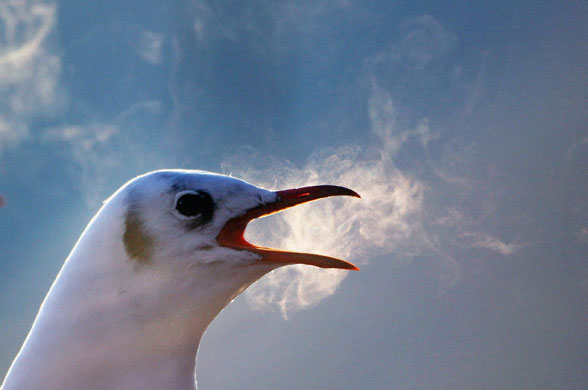TOP STORIES
Killer bat disease on the move
A mystery disease that has wiped out bat populations across the American north-east has now been discovered in Europe. A University College Dublin research team confirmed the fungal disease in a bat recovered in France.
“This is a dreadful disease,” said Dr Emma Teeling, of UCD’s School of Biology and Environmental Science, who led the research. “People were shocked because you get 100 per cent mortality.”
. . . She and her colleagues from UCD and France are the first research team to confirm the presence of the deadly fungal agent Geomyces destructans in a European bat.
The Irish Times - www.irishtimes.com
07 January 2010
D Ahlstrom
Photo courtesy of The Irish Times
07 January 2010
D Ahlstrom
Photo courtesy of The Irish Times
Other Bat News
Bird flu scare in Kaziranga, birds found dead
A bird flu scare has hit the Kaziranga National Park in Assam with carcasses of at least a dozen migratory Bar-headed Geese found in the sanctuary, officials said Friday.
A park warden said at least seven geese were found dead Friday. Five carcasses of the same species that had recently arrived at the sanctuary from Siberia were recovered Thursday.
"A team of experts, including veterinarians, are carrying out post-mortem of the birds and samples would be sent to Bhopal to find out if the deaths were due to avian influenza or some other disease," a park ranger told IANS.
Little About - www.littleabout.com (Source: Indo Asian News)
08 January 2010
Location: Assam, India - Map It
08 January 2010
Location: Assam, India - Map It

Dozens of native birds die in WA's south
Record temperatures are being blamed for the deaths of scores of birds in Western Australia's south.
The Department of Environment and Conservation (DEC) says it is investigating the deaths of more than 100 rare black cockatoos at Hopetoun, on the south coast, and more than 50 other birds 75km east of the township.
The dead birds have been found over two days since Wednesday, when the state's south sweltered through temperatures of up to 53 degrees Celsius.
The Sydney Morning Herald - news.smh.com.au (Source: AAP)
08 January 2010
Location: Hopetoun - Map It , Mungilnup - Map It
, Mungilnup - Map It  , Western Australia, Australia
, Western Australia, Australia
08 January 2010
Location: Hopetoun - Map It
 , Mungilnup - Map It
, Mungilnup - Map It  , Western Australia, Australia
, Western Australia, AustraliaMore Climate-Affecting-Wildlife News
>>> Snow stories: wildlife on the 'brink of crisis' in big freeze [UK, Scotland, Wales]
>>> Rescuers round up cold-sapped critters [Florida, USA; includes videos]
 Behind Mass Die-Offs, Pesticides Lurk as Culprit
Behind Mass Die-Offs, Pesticides Lurk as CulpritEver since Olga Owen Huckins shared the spectacle of a yard full of dead, DDT-poisoned birds with her friend Rachel Carson in 1958, scientists have been tracking the dramatic toll on wildlife of a planet awash in pesticides.
. . . In the past dozen years, no fewer than three never-before-seen diseases have decimated populations of amphibians, bees, and — most recently — bats.
A growing body of evidence indicates that pesticide exposure may be playing an important role in the decline of the first two species, and scientists are investigating whether such exposures may be involved in the deaths of more than 1 million bats in the northeastern United States over the past several years.
Yale Environment 360 - www.e360.yale.edu
07 January 2010
S Shah
Photo courtesy of Yale Environment 360
07 January 2010
S Shah
Photo courtesy of Yale Environment 360
TOP READ LINKS FROM LAST WEEK
- Pace of bat die-off called historic
- Scientists Discover Origin of a Cancer in Tasmanian Devils
- Scientists warn of rise in diseases spread from animals to humans
- Animal magic: the wildlife discoveries of 2009
- One Health Summit and study setting stage for policies, initiatives
OTHER WILDLIFE HEALTH RELATED NEWS
Photo credit: D Kitwood/Getty Images
- The week in wildlife

- Bighorn sheep monitored for disease in NV
- Chronic Wasting Disease not detected in Ohio deer
- Which animal species are most likely to get flu?
- Coral Reefs Generate Life [includes video, 1:58]
Huh, That's Interesting!
- Two killer whale types found in UK waters [cited journal article]
- Old Christmas trees overboard for fish habitat
It Ain't All Bad News
- Camera traps yield first-time film of tigress and cubs [includes video, 1:13]
- Wild Sumatran tiger cubs caught on film for first time [includes video, 1:17]
- The Great California Condor Comeback
- 800-pound leatherback sea turtle released back into the wild




